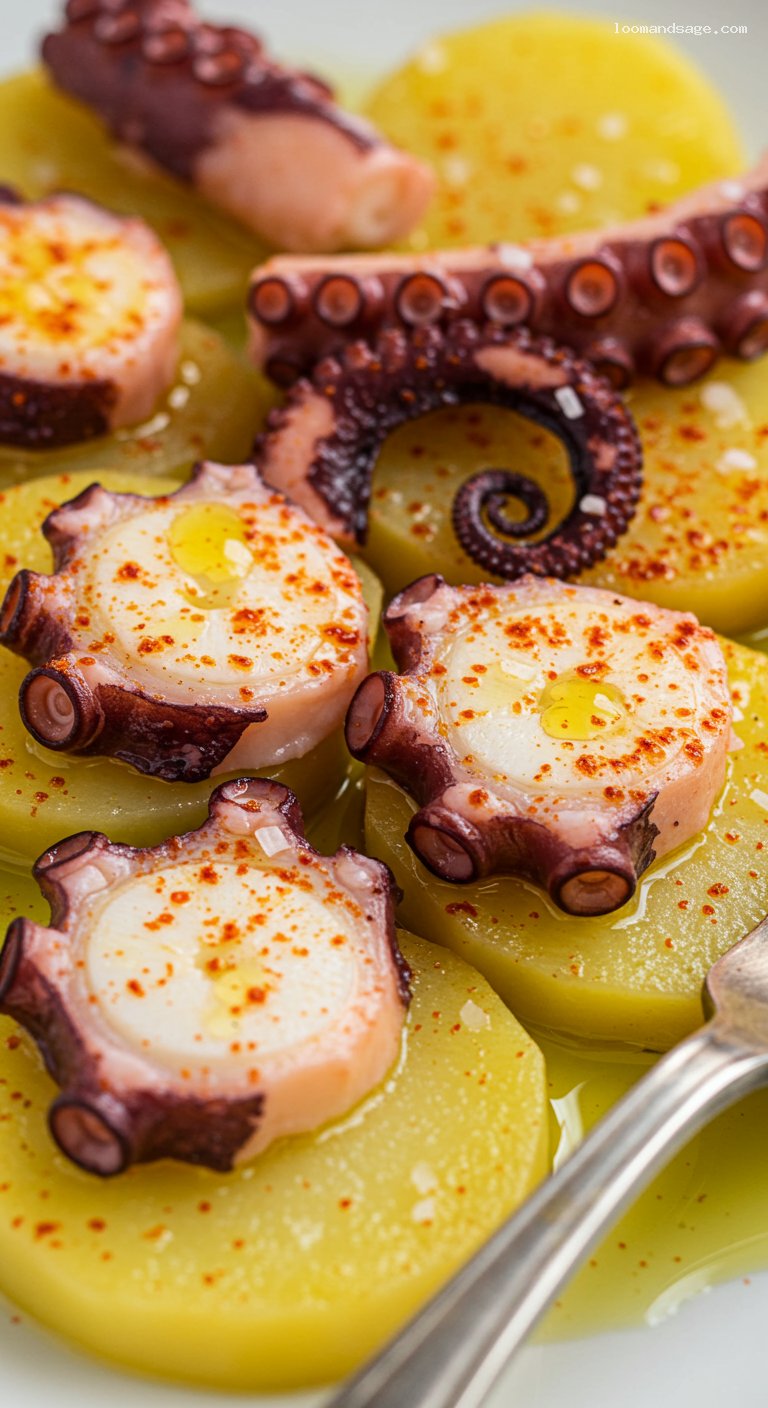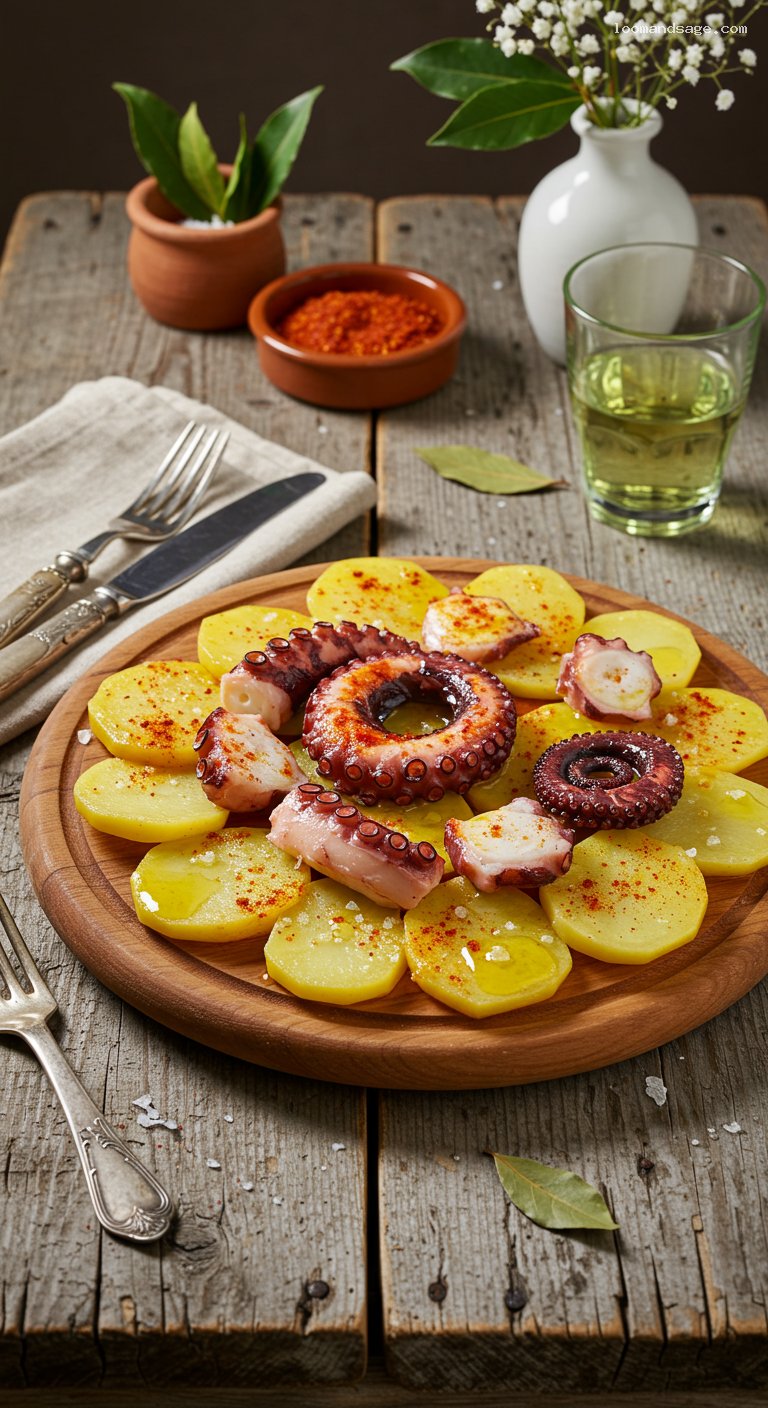Quick Recipe Version (TL;DR)
Quick Ingredients
- 1 whole octopus, 1.3 kg (about 3 lb), cleaned
- 1 small onion, halved
- 2 bay leaves + 6 black peppercorns
- 600 g waxy potatoes (about 4 medium), peeled and sliced 1 cm thick
- 1 tbsp kosher salt (for potato water)
- 80 ml (1/3 cup) extra-virgin olive oil
- 2 tsp sweet Spanish paprika (pimentón dulce)
- 1/2 tsp hot Spanish paprika (pimentón picante)
- 1 tsp coarse sea salt (for finishing)
Do This
- 1. Bring 3 L water with onion, bay leaves, and peppercorns to a boil. Dip octopus in and out 3 times to curl, then simmer at 85–90°C (185–195°F) for 45–55 minutes until tender.
- 2. Turn off heat and let the octopus rest in the hot liquid for 10 minutes.
- 3. Ladle 2 L cooking liquid into a pot, add 1 tbsp kosher salt, bring to a boil, and simmer potato slices 15–18 minutes until just tender.
- 4. Lift octopus out, separate tentacles, and slice into 1 cm medallions with kitchen shears.
- 5. Drain potatoes and arrange on a warm platter or wooden plate. Top evenly with octopus slices.
- 6. Spoon over olive oil, dust generously with sweet and hot paprika, and finish with coarse sea salt. Serve immediately.
Why You’ll Love This Recipe
- Classic Galician tapas: simple ingredients, brilliant flavor.
- Ultra-tender octopus with buttery potatoes and smoky paprika.
- Ready in under 2 hours, mostly hands-off simmering.
- Restaurant-quality plating at home with minimal fuss.
Grocery List
- Produce: 600 g waxy potatoes, 1 small onion
- Dairy: None
- Pantry: Whole octopus (about 1.3 kg), bay leaves, black peppercorns, kosher salt, coarse sea salt, sweet Spanish paprika, hot Spanish paprika, extra-virgin olive oil
Full Ingredients
For Cooking the Octopus
- 1 whole octopus, 1.3 kg (about 3 lb), cleaned (beak removed; head sac emptied)
- 3 liters water
- 1 small onion, halved
- 2 bay leaves
- 6 whole black peppercorns
For the Potatoes
- 600 g waxy potatoes (Yukon Gold or similar), peeled and sliced into 1 cm rounds
- 2 liters octopus cooking liquid (reserved)
- 1 tablespoon kosher salt (for potato water)
To Finish
- 80 ml (1/3 cup) high-quality extra-virgin olive oil (Spanish Arbequina or Picual recommended)
- 2 teaspoons sweet Spanish paprika (pimentón dulce)
- 1/2 teaspoon hot Spanish paprika (pimentón picante), to taste
- 1 teaspoon coarse sea salt or flaky salt
- Optional: 1/2 teaspoon smoked paprika for extra smokiness

Step-by-Step Instructions
Step 1: Set up a fragrant simmering bath
In a large pot, combine 3 liters of water, the halved onion, bay leaves, and peppercorns. Bring to a rolling boil over high heat. Have tongs ready and keep the octopus near the pot.
Step 2: Curl the tentacles and cook gently
Grasp the octopus by the head and dip it into the boiling water for 2–3 seconds, then lift it out. Repeat this “scare” technique three times; the tentacles will curl and firm up. After the third dip, submerge the octopus fully, reduce heat to maintain a gentle simmer at 85–90°C (185–195°F), and cook uncovered for 45–55 minutes. Begin checking at 45 minutes: a skewer should slide into the thickest part of a tentacle with slight resistance, like a cooked potato.
Step 3: Rest in the hot broth
Turn off the heat and let the octopus rest in the hot liquid for 10 minutes. This relaxes the muscle fibers and keeps the meat supple. Meanwhile, heat serving plates (or a wooden “plato de pulpo”) in a low oven at 90–100°C (195–210°F).
Step 4: Cook the potatoes in octopus broth
Ladle 2 liters of the octopus cooking liquid into a separate pot and bring to a boil. Add 1 tablespoon kosher salt, then the potato slices. Reduce to a gentle simmer and cook 15–18 minutes until just tender but not falling apart. Drain and keep warm.
Step 5: Slice the octopus
Lift the octopus from the pot and transfer to a cutting board. Separate the tentacles and, using kitchen shears, cut them into 1 cm thick medallions. Slice some of the head meat as well—it’s delicious and tender. If needed, keep the slices warm by tenting with foil.
Step 6: Plate the Galician-style arrangement
Arrange the warm potato rounds in a slightly overlapping layer on your warm plate or wooden board. Distribute the octopus medallions over the potatoes so every bite gets both elements. Spoon the olive oil evenly over the top.
Step 7: Season boldly and serve
Dust the surface with the sweet paprika, then sprinkle the hot paprika to taste (and a pinch of smoked paprika if using). Finish with coarse sea salt. Serve immediately while everything is warm and glossy.
Pro Tips
- Frozen octopus actually cooks more tenderly than fresh; thaw in the fridge overnight before cooking.
- Keep the simmer gentle—barely bubbling. Vigorous boiling can toughen the flesh.
- Use kitchen shears for clean, even medallions that won’t shred the suction cups.
- Spanish pimentón matters: choose a fresh, high-quality sweet and hot paprika for authentic aroma and color.
- Reserve leftover octopus broth—it is liquid gold for rice, potato soup, or a seafood stew.
Variations
- A Feira (most traditional): Use only sweet paprika and coarse sea salt with olive oil.
- Smoky Twist: Replace half the sweet paprika with smoked pimentón de la Vera.
- Quick Weeknight: Substitute 700 g pre-cooked vacuum-packed octopus; warm gently in the broth for 5 minutes, then proceed from slicing.
Storage & Make-Ahead
Cooked octopus can be made 1–2 days ahead. Cool it in its cooking liquid and refrigerate; rewarm gently in hot broth before slicing. Boiled potatoes are best the day of, but you can par-cook them 10 minutes, cool, and finish just before serving. Store leftovers (octopus and potatoes separately) in airtight containers up to 2 days. Reheat octopus by gently warming in broth or a covered pan with a splash of water; avoid high heat. Potatoes reheat best by steaming or in the microwave covered until warm.
Nutrition (per serving)
Approximate: 440 calories; 20 g fat; 36 g carbohydrates; 34 g protein; 1,000 mg sodium (varies with finishing salt); 3 g fiber.


